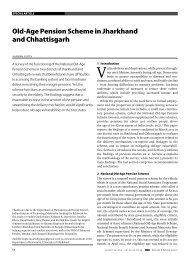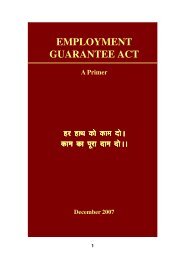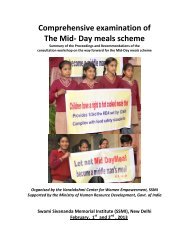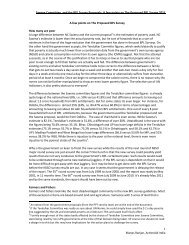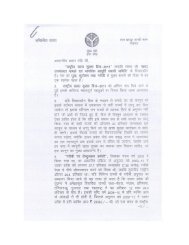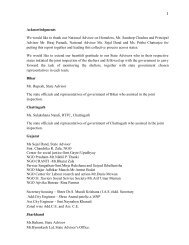NREGA: Opportunities and Challenges - Diksha
NREGA: Opportunities and Challenges - Diksha
NREGA: Opportunities and Challenges - Diksha
You also want an ePaper? Increase the reach of your titles
YUMPU automatically turns print PDFs into web optimized ePapers that Google loves.
<strong>NREGA</strong>: OPPORTUNITIES AND CHALLENGESSHOULD ROAD CONSTRUCTION BE TAKEN OUT OF <strong>NREGA</strong>?The rural development ministry is looking at a proposal to remove rural connectivity from the list of nine recommendedtypes of work under the National Rural Employment Guarantee Act (<strong>NREGA</strong>). The argument is that the Pradhan MantriGram Sadak Yojana (PMSY) is a dedicated programme for rural road construction. PMSY aims at providing all weatherconnectivity to habitations with 500 <strong>and</strong> above (a population of 250 for hilly, desert <strong>and</strong> tribal areas). Even while reviewingthe agricultural policy of Karnataka recently, Prime Minister Manmohan Singh had said that <strong>NREGA</strong> funds could be used forimproving the productivity of those agricultural l<strong>and</strong> owned by those marginal farmers belonging to below poverty lines.“While most of the Karnataka’s large arid tract are covered under <strong>NREGA</strong>, still more than 28 per cent of the funds is beingspent on rural connectivity for which government separately funds the rural roads programme,” said Man Mohan Singh.Rural connectivity occupies the bottom position on the list of recommended works under the <strong>NREGA</strong>. Out of a total12.3 lakh number of direct projects under the <strong>NREGA</strong> across 330 districts, more than 2 lakh were related to rural connectivityalone during the April to December period of the current fiscal.In Assam, the focus on road construction is impacting the <strong>NREGA</strong> implementation. Forty-one households of DisobaiMauzadar Terang village of Langsomepi Development Block worked under <strong>NREGA</strong> to remove the grass <strong>and</strong> throw thegravel on the already existing road. “A community pond could have been dug which would have helped fruit cultivation<strong>and</strong> horticulture,” says Longbram Ingti, a farmer. 4 In Orissa more than 37 per cent of total completed <strong>and</strong> ongoing projectsare road connectivity projects. As high as 59 per cent of total expenditure incurred for road connectivity projects while lessthan 36 per cent of expenditure was made on water harvesting/conservation, drought proofing like activities. In a survey of1200 households in Rajasthan’s Sirohi district by the Institute of Social Studies Trust, it was found that gravel roads aregetting precedence despite the district’s water scarcity. It found that during 2006-07, gravel roads have got precedence overother works.onset of the monsoons during the current fiscal. “Due to non-completion of many water works, they aresusceptible to damages. My observation shows that we have already lost around 60-70 per cent of worksnewly created under the <strong>NREGA</strong>,” says Harnath Jagawat of the Gujarat-based MM Sadguru Water <strong>and</strong>Development Foundation.Going to the drainThe CSE study found that bad planning for the water conservation structures <strong>and</strong> lack of maintenance arealready putting a large number of the assets created into disuse. Water harvesting structures have beencreated without any provision for catchment protection. For example, Kanchanpur village in Sidhi districthas built three huge tanks under <strong>NREGA</strong>; their catchments are in forest areas. “Most of the catchmentsare degraded <strong>and</strong> the forest department doesn’t allow us to treat them. So I am sure that in two years, thetanks would be silted up,” says Kunwar Singh, a social worker based in Sidhi. Earlier, the village hadconstructed three check dams; all of them have silted up beyond repair. “The district initiated work onaround 500 tanks <strong>and</strong> water harvesting structures in the first three months of <strong>NREGA</strong> implementation.There was hardly any thinking on from where the water would flow into these tanks. My field visits show methat most of these tanks would burst in monsoon or be silted up within a year. Their catchments are highlydegraded,” says Ashok Kumar Shah, the district Panchayat president.The issue of maintenance has to be addressed urgently as well. <strong>NREGA</strong> doesn’t allow maintenance workas a permissible activity. This alone has the potential to undo whatever has been achieved. Also, thiscomes as a problem for the districts which have already large number of water harvesting structures <strong>and</strong>want to use <strong>NREGA</strong> money for maintenance (see Table: Structure of spending of <strong>NREGA</strong> funds). InDungarpur district of Rajasthan, floods have washed away most of the new water conservation structuresconstructed under <strong>NREGA</strong>. A total of 2,377 water harvesting structures – anicuts, check-dams, gabianstructures <strong>and</strong> water channels – had been built in Dungarpur since the launch of <strong>NREGA</strong> from April 2006.Around 80 per cent of them have been washed away. “As <strong>NREGA</strong> allows only minimum usage ofmachinery, we are finding it difficult to build structures which would last longer periods of time,” saysNeeraj K Pawan, district collector, Dungarpur.Sidhi district in Madhya Pradesh is an example of how without any provision for maintenance, assetscreated are put to disuse. The district has spent substantially on water conservation works under <strong>NREGA</strong>.43



